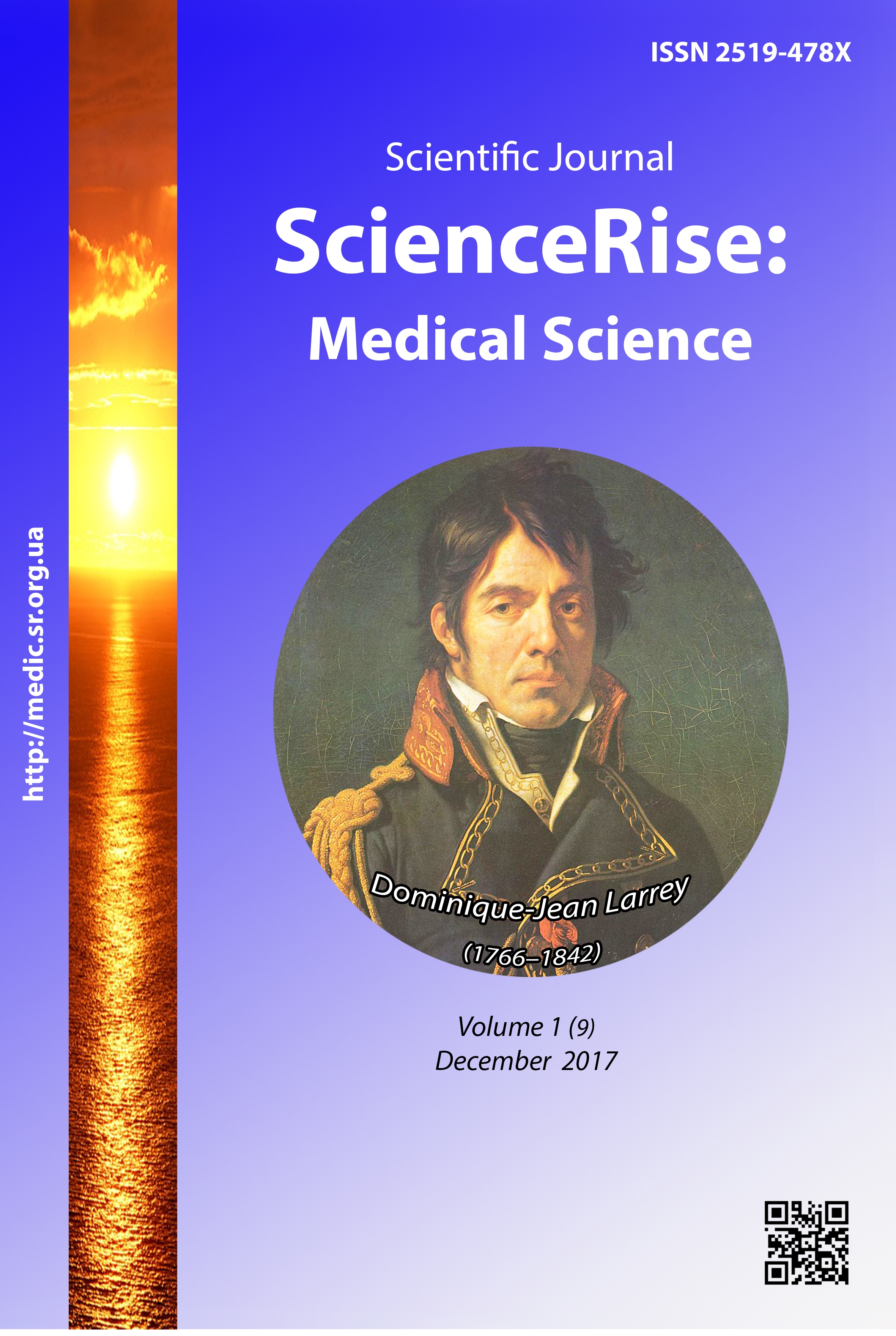LEPR q223r gene polymorphism in patients having coronary heart disease with postinfarction cardiosclerosis and type 2 diabetes
DOI:
https://doi.org/10.15587/2519-4798.2017.90965Keywords:
coronary heart disease, leptin receptors, polymorphism, adiponectin and leptinAbstract
Aim. To determine the prevalence of mononucleotide leptin receptor gene LEPR Q223R polymorphism in patients having coronary heart disease (CHD) with postinfarction cardiosclerosis depending on type 2 diabetes comorbidity.
Materials and methods. 147 patients having stable CHD with postinfarction cardiosclerosis (100% male), the average age of 52, were examined. In 64 (43.5%) patients CHD combined with type 2 diabetes. The CHD diagnosis was established by АНА/АСС (2014) and ESC (2013) recommendations. LEPR Q223R (Gln223Arg, rs1137101) gene polymorphism was determined using allele-specific polymerase chain reaction in real time.
Results and discussion. In the group of patients having CHD with postinfarction cardiosclerosis (Podillya region inhabitants) the frequency of LEPR Q223R gene genotypes was as follows: QQ – 25.2 %, QR – 42.4 %, RR – 32.7 %. The frequency of R allele in patients having CHD was significantly higher than in the practically healthy group, and was 53.7 to 41.3% (χ2=4.72, р=0.03). Сomorbidity chances significantly increase in R allele carriers (OR=1.58, 95 % СІ 0.99-2.53), while Q allele carrier state have a protective value (OR=0.63, 95 % СІ 0.40-1.01). RR genotype associated with CHD earlier debut, higher frequency of Q- myocardial infarction (OR=4.3; 95 % СІ 1.51-12.5) and heart failure progression (OR=3.60; 95 % СІ 1.67-7.77).
Conclusion. RR genotype LEPR Q223R gene carrier state is a potential unmodified factor that accelerates development and increases the severity of CHD, associated with type 2 diabetes, in malesReferences
- Melkozerov, K. V., Kalashnikov, V. Y., Terekhin, S. A., Bondarenko, O. N. (2012). Ichemicheskaia bolezn serdca u bolnich sacharnim diabetom i kriticheskoy ishemiei nignich konechnostei. Diabetes, 3, 39–44.
- Shatohіna, І. V. (2012). Tsukrovy dіabet 2 type yak chinnik, scho obtyazhuє perebіg іnfarktu mіokarda u chvorich s arterіalnoyu gіpertenzіyu. Klіnіchna endokrinologіya ta endokrinna hіrurgіya, 2 (39), 37–70.
- Sachdev, M., Sun, J. L., Tsiatis, A. A., Nelson, C. L., Mark, D. B., Jollis, J. G. (2004). The prognostic importance of comorbidity for mortality in patients with stable coronary artery disease. Journal of the American College of Cardiology, 43 (4), 576–582. doi: 10.1016/j.jacc.2003.10.031
- Tauseef, A., Fareed, W., Bugti, A., Naim, M. H., Lashari, M. N. (2015). Frequency of comorbidities and risk factors among ischaemic heart disease patients in Karachi – perspective from three tertiary care hospitals. Journal Of Pakistan Medical Association, 65 (2), 235–238.
- Babak, M. O. (2010). Role polіmorfіzmu genіv adipokіnіv (adiponectin ta leptin) y rozvitku ozhirіnnya ta asotsіyovanih s ozhirіnnyam dysplasticnich zmin slizovoi obolonki stravohodu. Ukrai'ns'kyj terapevtychnyj zhurnal, 3, 15–22.
- Dias, N. F., Fernandes, A. E., Melo, M. E. de, Reinhardt, H. L., Cercato, C., Villares, S. M. F. et. al. (2012). Lack of mutations in the leptin receptor gene in severely obese children. Arquivos Brasileiros de Endocrinologia & Metabologia, 56 (3), 178–183. doi: 10.1590/s0004-27302012000300005
- Guízar-Mendoza, J. M., Amador-Licona, N., Flores-Martínez, S. E., López-Cardona, M. G., Ahuatzin-Trémary, R., Sánchez-Corona, J. (2005). Association analysis of the Gln223Arg polymorphism in the human leptin receptor gene, and traits related to obesity in Mexican adolescents. Journal of Human Hypertension, 19 (5), 341–346. doi: 10.1038/sj.jhh.1001824
- Suriyaprom, K., Tungtrongchitr, R., Thawnasom, K. (2014). Measurement of the levels of leptin, BDNF associated with polymorphisms LEP G2548A, LEPR Gln223Arg and BDNF Val66Met in Thai with metabolic syndrome. Diabetology & Metabolic Syndrome, 6 (1), 6. doi: 10.1186/1758-5996-6-6
- Bienertova-Vasku, J. A., Spinarova, L., Bienert, P., Vasku, A. (2009). Association between variants in the genes for leptin, leptin receptor, and proopiomelanocortin with chronic heart failure in the Czech population. Heart and Vessels, 24 (2), 131–137. doi: 10.1007/s00380-008-1090-5
- Ghali, Z. H., Ahmed, I. H., Gorshunska, M. Yu., Pоchеrnyaev, A. K., Atramentova, L. A. (2012). Structure of Ukrainian population on SNP rs1137101 of leptin receptor gene LEPR. The Journal of V. N. Karazin Kharkiv National University. Series: biology, 15 (1008), 94–98.
- Paracchini, V. (2005). Genetics of Leptin and Obesity: A HuGE Review. American Journal of Epidemiology, 162 (2), 101–114. doi: 10.1093/aje/kwi174
- Bender, N., Allemann, N., Marek, D., Vollenweider, P., Waeber, G., Mooser, V. et. al. (2011). Association between Variants of the Leptin Receptor Gene (LEPR) and Overweight: A Systematic Review and an Analysis of the CoLaus Study. PLoS ONE, 6 (10), e26157. doi: 10.1371/journal.pone.0026157
- Salopuro, T., Pulkkinen, L., Lindström, J., Eriksson, J. G., Valle, T. T., Hämäläinen, H. et. al. (2005). Genetic variation in leptin receptor gene is associated with type 2 diabetes and body weight: The Finnish Diabetes Prevention Study. International Journal of Obesity, 29 (10), 1245–1251. doi: 10.1038/sj.ijo.0803024
- Roszkowska-Gancarz, M., Kurylowicz, A., Polosak, J., Mossakowska, M., Franek, E., Puzianowska-Kuźnicka, M. (2014). Functional polymorphisms of the leptin and leptin receptor genes are associated with longevity and with the risk of myocardial infarction and of type 2 diabetes mellitus. Endokrynologia Polska, 65 (1), 11–16. doi: 10.5603/ep.2014.0002
Downloads
Published
How to Cite
Issue
Section
License
Copyright (c) 2017 Микола Адамович Станіславчук, Наталія Валентинівна Заічко, Аль Салім Аяд Абдуллах

This work is licensed under a Creative Commons Attribution 4.0 International License.
Our journal abides by the Creative Commons CC BY copyright rights and permissions for open access journals.
Authors, who are published in this journal, agree to the following conditions:
1. The authors reserve the right to authorship of the work and pass the first publication right of this work to the journal under the terms of a Creative Commons CC BY, which allows others to freely distribute the published research with the obligatory reference to the authors of the original work and the first publication of the work in this journal.
2. The authors have the right to conclude separate supplement agreements that relate to non-exclusive work distribution in the form in which it has been published by the journal (for example, to upload the work to the online storage of the journal or publish it as part of a monograph), provided that the reference to the first publication of the work in this journal is included.









